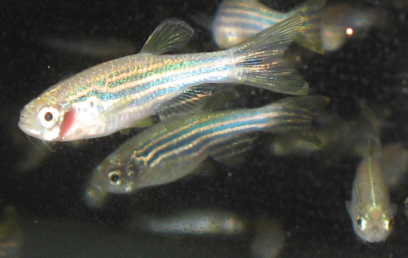Following the extension of the fish facilities of the Institute of Toxicology and Genetics (ITG), more than 8000 aquariums are now available to scientists in Karlsruhe. Research focuses on the systematic analysis of key molecules in development and regeneration processes and, thus, provides a major contribution to the Helmholtz BioInterfaces Research Program. Mainly, embryos of small freshwater fishes, such as the zebrafishes or the Japanese medaka, are used.
The extension of the ITG took half a year and still is well-timed. “Now, we can conduct research on up to 300,000 fishes, underline the heads of the institute, Professor Uwe Strähle and Professor Jochen Wittbrodt. “With this, we are the leaders in Europe”. This advantage will have to be made use of: It is the long-term objective to develop biotechnological methods and new therapies to cure human diseases. In the past years, a number of fish-models for human diseases, ranging from cancer, to cardiovascular diseases, myopathy, and neurodegenerative diseases, were identified. Studies of the freshwater fishes allow to understanding the molecular causes of such diseases and developing new therapies. Another central research focus in the BioInterfaces Program consists in the development of technologies for specific tissue regeneration.
Freshwater fishes, such as the zebrafish and the Japanese medaka, are excellent model-systems in this regards, since many of their genes are identical to those of human. Due to the transparency of their embryos, the functions of these genes in development and tissue regeneration is well observable. As the fish embryos are rather sensitive to external influences, they are also suited for a systematic analysis of the bioactivity and toxicity of chemical substances. Therefor, the Karlsruhe researchers wish to rapidly develop applicable detection methods. Thereby, the use of novel microscope systems developed by the KIT in close cooperation with industry will be helpful: These systems should detect and analyze the embryos fully automatically.
In biomedical basic research model organisms, similar to human in many respects, are used since a long time. Studies of fishes are not only scientifically promising, but also ethically unobjectionable: In opposition to embryonal research on mice or rats, fish-mothers do not have to be killed.
The Karlsruhe Institute of Technology (KIT) is the merger of the Forschungszentrum Karlsruhe, member of the Helmholtz Association, and the Universität Karlsruhe. This merger will give rise to an institution of internationally excellent research and teaching in natural and engineering sciences. In total, the KIT has 8000 employees and an annual budget of 700 million Euros. The KIT focuses on the knowledge triangle of research – teaching – innovation.
The Karlsruhe institution is a leading European energy research center and plays a worldwide visible role in nanosciences. KIT sets new standards in teaching and promotion of young scientists and attracts top scientists from all over the world. Moreover, KIT is a leading innovation partner of industry.

